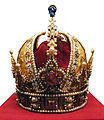 | ||
Imperial crown frysk fanfare orkest
An Imperial Crown is a crown used for the coronation of emperors.
Contents
- Imperial crown frysk fanfare orkest
- Imperial crowns ramblin woman blues live at rockpalast
- Design
- Heraldic Imperial Crowns
- References
Imperial crowns ramblin woman blues live at rockpalast
Design
Crowns in Europe during the medieval period varied in design:
An open crown is one which consists basically of a golden circlet elaborately worked and decorated with precious stones or enamels. ... The medieval French crown was of this type. ... the closed crown, which had bands of metal crossing usually from one side to the other and from back to front so that they met in the middle, at the top of the head. ... These arches are in part utilitarian, since they serve to strengthen the crown,in part decorative, since they are normally made to serve as supports for a central cross or jewel, and in part traditional, since a contributing element to the evolution of many medieval crowns was the structure of the early Germanic helmet, which had metal bands crossing at the top of the head to protect the skull from injury.
During the medieval era the crowns worn by English kings had been described as both closed (or arched) and open designs. This was in contrast with kings of France who always wore an open crown. However, there is academic debate on how often closed crowns were used in England during this period, as the first unequivocal use of the closed crown was by Henry IV at his coronation on 13 October 1399. However his effigy on his tomb in Westminster Abbey wears an open crown so the link in England between the style of the crown and its representation as that worn by a king and an emperor was not established. The use of a closed crown may have been adopted by the English as a way of distinguishing the English crown from the French crown, but it also had other meanings to some. For example, Henry V wore helmet-crown of the arched type at the Battle of Agincourt which the French knight St. Remy commented was "like the imperial crown".
The association of the closed crown with imperial crowns was already established in Continental Europe the late 14th century for example the florins minted for Charles IV, Holy Roman Emperor) sometimes show him with an closed crown (though on the commoner variety, the crown is open). A miniature picture in the Chronica Aulae Regiae written in the great abbey outside Prague depicts his mother Elizabeth a queen of Bohemian wearing an open crown, while his two wives, who had imperial titles, have closed ones.
During the machinations that surrounded the introduction of the imperial crown under Henry VIII (see the section below Legal usage), the closed crown, became associated as a symbolic representation of the English Crown as an imperial crown, and has remained so until this day.
The Silk Imperial Crown of Russia was used as an official coronation gift of the Russian Empire for the coronation of Nicholas II, the last Emperor of the Romanov line. Nicholas II was the first and only monarch to be presented with such a monumental coronation gift. It was not intended as ceremonial regalia, but as private Imperial property - a memento to his coronation event.
Heraldic Imperial Crowns
A list of prominent examples of depictions of imperial crowns displayed atop heraldic achievements or as heraldic charge includes:
Because Pope Clement VII would not grant Henry VIII of England an annulment of his marriage to Catherine of Aragon, the English Parliament passed the Act in Restraint of Appeals (1533) in which it was explicitly stated that
Where by divers sundry old authentic histories and chronicles it is manifestly declared and expressed that this realm of England is an empire, and so hath been accepted in the world, governed by one supreme head and king, having the dignity and royal estate of the imperial crown of the same.The next year the Act of Supremacy (1534) explicitly tied the headship of the church to the imperial crown:
The only supreme head in earth of the Church of England called Anglicana Ecclesia, and shall have and enjoy annexed and united to the imperial crown of this realm.During the reign of Mary I the First Act of Supremacy was annulled, but during the reign of Elizabeth I the Second Act of Supremacy, with similar wording to the First Act, was passed in 1559. During the English Interregnum the laws were annulled, but the acts which caused the laws to be in abeyance were themselves, deemed to be null and void by the Parliaments of the English Restoration, so by act of Parliament The Crown of England and (later the British and UK crowns) are imperial crowns.
